How Alexander Yaroslavich defeated the German knights
In 1240, the Livonian knights at the head of military units from the Russian cities of Yuriev and Medvezhya Golova, previously subordinated to them, launched an offensive against Pskov land. The ally of the Crusaders was the Russian prince Yaroslav Vladimirovich, who was once driven out of Pskov. First, the knights took the Pskov border fortress Izborsk. Towards the enemy hastily moved the Pskov militia. However, it was broken. Pskov voivode Gavrila Borislavich was killed, many Pskovs fell, others were captured, and others fled. In the footsteps of the retreating Pskovs, the German knights broke into the Pskov Posad, but they could not take a strong stone fortress that had repeatedly stopped the enemy. Then the traitors came to the aid of the conquerors from the number of boyars headed by posadnik Tverdiloy Ivankovich. They let 1240 of the year into the Pskov Krom (Kremlin) of the Germans in September. Part of the Pskov boyars, unhappy with this decision, fled with their families to Novgorod.
Thus, the quarrel with Prince Alexander Yaroslavich adversely affected the defense capability of Veliky Novgorod. Having made Pskov and Izborsk their bases, the Livonian knights in the winter of 1240 - 1241. invaded the Novgorod possessions of Chud and Vod, devastated them, besieged the inhabitants with tribute. After the seizure of the Pskov lands, the knights of the crusaders began to systematically strengthen themselves in the occupied territories. This was their usual tactic: on the territory seized from a hostile people, the Western knights immediately cost outposts, fortifications, castles and fortresses, in order to continue the offensive against them. On the steep and rocky mountain in the Koporye graveyard, they built an order's castle with high and strong walls, which became the basis for further progress to the east. Shortly thereafter, the Crusaders captured Tesovo, an important trading point in the Novgorod land, and from there it was already within reach of Novgorod. In the north, the knights reached Luga and became impudent to the point that they robbed on the roads in 30 versts from Novgorod. Simultaneously with the knights, though quite independently of them, Lithuanians began to make raids in the Novgorod parish. They used the weakening of Novgorod Russia and plundered the Russian lands.
It is clear that the people of Novgorod were alarmed. The Order was a powerful and formidable force that inexorably absorbed the eastern lands, turning the local population to the western version of Christianity with fire and sword. In the face of an imminent threat, simple Novgorodians forced the boyar “lord” to call Prince Alexander for help. Novgorod's ruler Spiridon himself went to Pereslavl, who asked the prince to forget the previous offenses and to lead the Novgorod troops against the German knights. Alexander returned to Novgorod, where he was greeted by popular triumph.
In 1241, Prince of Novgorod Alexander Yaroslavich Nevsky with the prince's retinue and militia from Novgorod, Ladozhan, Izhora and Karelia stormed the Koporye fortress and freed the Vody land of Veliky Novgorod from the influence of the Order on the coast of the Gulf of Finland. The fortress was razed, the captured knights were sent hostage to Novgorod, and the traitors who served them were hanged. Now there was the task of liberating Pskov. However, to conduct further struggle with a strong enemy, the capabilities of the formed army were not enough, and Prince Alexander called upon the brother of Prince Andrei Yaroslavich with his retinue, Vladimir residents and Suzdalians.
Novgorod-Vladimir army made a campaign in the liberation of Pskov in the winter of 1241-1242 of the year. Alexander Yaroslavich acted as always swiftly. The Russian army forced march came to the nearest approaches to the city and cut off all the roads in Livonia. There was no long siege, followed by the assault on a strong fortress. Knightly garrison could not withstand the fierce onslaught of Russian soldiers and was defeated, those who survived, laid down weapon. Pskov boyars traitors were executed. Then released and Izborsk. Thus, the combined Russian army liberated the cities of Pskov and Izborsk from the crusaders.
The fall of a powerful fortress with a strong garrison was a great surprise for the leadership of the Livonian Order. In the meantime, Alexander Nevsky transferred the fighting to the land of the Estonian tribe, conquered by the Order's brothers. The Russian commander pursued one goal - to force the enemy to go beyond the walls of knightly castles into an open field for a decisive battle. And even before the arrival of reinforcements from the German states. Such a calculation was justified.
Thus, Alexander repulsed the territories seized by the crusaders. However, the struggle was not over yet, as the Order retained its living force. There was a decisive battle that was to determine the outcome of the war. Both warring parties began to prepare for the decisive battle and announced a new collection of troops. The Russian army gathered in liberated Pskov, and the Teutonic and Livonian knights in Dorpat-Yuryev. Victory in the war decided the fate of North-Western Russia.
Battle on the Ice. Artist V.A. Serov
Battle on the Ice
The Master of the Order, the Bishops of Dorpat, Riga and Ezel, united all the military forces they had for the war with Veliky Novgorod. The Livonian knights and their vassals, the knights of the bishops and the personal units of the Catholic bishops of the Baltic states, the Danish knights arose from their beginning. Arrived knights adventurers, mercenaries. As auxiliary troops, Estonians, Livs, and foot soldiers from other nations enslaved by German conquerors were forcibly recruited. In the spring of 1242, the army of the knights of the crusaders, consisting of knightly cavalry and infantry (knights) from Livs, conquered by the Chudi order, and others, moved to Russia. 12 thousand knight army led by Vice-Master of the Teutonic Order A. von Velven. The Russian army consisted of 15-17 thousand people.
It is worth remembering that the knights themselves were relatively few. But each knight led the so-called. spear "- a tactical unit, a small squad, which consisted of the knight himself, his squires, bodyguards, swordsmen, spearmen, archers and servants. As a rule, the richer was the knight, the more soldiers he numbered his “spear”.
Prince Alexander Yaroslavich led the Russian army along the coast of Pskov Lake "with care." A large detachment of light cavalry under the command of Domash Tverdislavich and the governor of Tver, Kerbet, was sent forward. It was necessary to find out where the main forces of the Livonian Order are and what route they will take to Novgorod. Near the Estonian village of Hammast (Mooste), the Russian “watchman” collided with the main forces of the Livonian knights. There was a stubborn battle in which the Russian detachment was defeated and went to his own. Now the prince could say with certainty that the enemy would launch an invasion through the ice of Lake Peipsi. Alexander decided to take the battle there.
Alexander Yaroslavich decided to give a general battle in the most favorable conditions for him. Prince Novgorodsky occupied the narrow strait between the Peipsi and Pskov lakes with its shelves. This position was very successful. Crusaders, passing on the frozen river r. Emaygi to the lake, could then go to Novgorod bypassing Lake Peipsi to the north, or Pskov - along the western coast of the Pskov lake to the south. In each of these cases, the Russian prince could intercept the enemy, moving along the eastern coast of the lakes. If the knights decided to act directly and tried to overcome the strait in the narrowest place, such as the Warm Lake, then they would directly encounter Novgorod-Vladimir troops.
According to the classical version, the decisive battle between the Russian troops and the Crusaders occurred near the Voroniy Stone, adjacent to the eastern shore of the narrow southern part of Lake Peipsi. The selected position to the maximum extent took into account all the favorable geographical features of the area and put them in the service of the Russian commander. Behind our troops, there was a steep bank overgrown with dense forest, which excluded the possibility of bypassing enemy cavalry. The right flank was protected by a water zone called Sigovitsa. Here, due to some features of the flow and a large number of keys, the ice was very fragile. Local residents knew about it and, undoubtedly, informed Alexander. Finally, the left flank was protected by a high coastal cape, from where a wide panorama was opened up to the opposite shore.
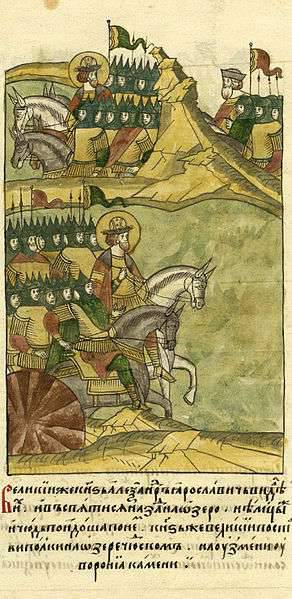
Russian army goes to Lake Peipsi. Chronicle miniature
Taking into account the peculiarity of the order tactics, when the knights, relying on the invincibility of their horse-drawn "armored fist", usually carried out a frontal attack with a wedge called "pig" in Russia, Alexander Nevsky placed his army on the eastern shore of Lake Peipsi. The location of the troops was traditional for Russia: the “forehead” (middle regiment) and the regiments of the left and right hands. Ahead stood the archers (advanced regiment), who were supposed to upset the enemy’s order at the beginning of the battle and weaken the very first terrible onslaught of the knights. The peculiarity was that Alexander decided to weaken the center of the military structure of the Russian army and strengthen the regiments of the right and left hands, the prince's cavalry divided into two units and positioned them on the flanks behind the infantry. Behind the "man" (regiment of the battle formation center) there was a reserve, a prince's squad. Thus, Alexander planned to tie up the enemy with a battle in the center, and when the knights got bogged down, strike covering blows from the flanks and bypass from the rear.
Source: Bloodless L. Atlas of maps and schemes for the Russian military stories
5 April 1242. With the rising of the sun the knightly wedge moved to the offensive. Russian archers met the enemy with a shower of arrows. Russian heavy bows were terrible weapons and caused the enemy serious damage. However, the knight's wedge continued the attack. Gradually, the archers retreated to the ranks of the infantry and finally merged with it in a single unit. Knights got the idea of the Novgorod foot rati. Began a fierce and bloody slashing. After the first ram strike with spears, swords, axes, maces, klevtsy, war hammers, etc. went into action. Knights broke through the weakened Russian center. About this critical episode for the Russian troops, the chronicler says: "And the Germans and the people are talking pigs through the shelves."
The Crusaders were ready to triumph, but the Germans rejoiced early. Instead of space for maneuver, they saw in front of them an invincible shore for the cavalry. And the remnants of a large regiment died, but they continued a fierce battle, weakening the enemy. At this time, both wings of the Russian army fell to the knight’s left and right, and an electoral squad of Prince Alexander struck from the rear, making a roundabout maneuver. “And by the way that evil was cut off, it was great by Germans and people, and a snow pipe from spears of breaking, and a sound from a sword section, and you would not see ice covered with blood.”
The fierce battle continued. But in the battle there was a turning point in favor of the Russian rati. Knightly army surrounded, cramped and began to break his order. The Novgorodians, surrounded and knocked down by knights, were dragged with horses by hooks. Horses broke legs, cut the veins. Hurried crusader, chained in heavy armor, could not resist pedestrian Russian soldiers. The case was completed with axes and other chopping and crushing weapons.
As a result, the battle ended in complete victory for the Russian army. The hired infantry (bollards) and the surviving knights ran. Part of the knightly troops were driven by Russian warriors to Sigovitsa. Fragile ice could not stand it and broke under the weight of crusaders and their horses chained in armor. The knights went under the ice, and there was no escape for them.
Battle on the Ice. V.M. Nazaruk
Battle results
So suffered a cruel defeat and a second campaign against the Rus crusaders. The Livonian Rhymed Chronicle claims that 20 knight brothers were killed in the Battle of the Ice and 6 were captured. The Chronicle of the Teutonic Order "Die jungere Hochmeisterchronik" reports about the death of the knights brothers 70. These losses do not take into account the fallen secular knights and other order warriors. In the First Novgorod Chronicle, the losses of the opponents of the Russians are presented as follows: “and ... the fall of the Beschtisla, and Nѣmets 400, and 50 by the hands of Yash and brought to Novgorod”. At the ceremonial entry of the prince into Pskov (according to other sources in Novgorod), the German "deliberate voevods" of the 50 German walked after the horse of Alexander Nevsky. It is clear that the losses of ordinary warriors, bollards, dependent militias from Finnish tribes were much higher. Russian losses are unknown.
The defeat in the battle on Lake Peipsi forced the Livonian Order to ask for peace: “What we went by the sword ... from that all retreat; how many have your people taken captive, by that we are exchanged: we will let yours go, but you will let ours go. " For the city of Yuriev (Dorpat), the Order pledged to pay Novgorod "Yuryev's tribute". Under a peace treaty concluded several months later, the Order abandoned all claims to Russian lands and returned the territories seized earlier. Thanks to decisive military victories, the crusaders suffered heavy losses, and the Order lost its strike power. For some time, the combat potential of the Order was weakened. It was only after 10 that the knights attempted to retake Pskov.
Thus, Alexander Yaroslavich stopped the broad crusader aggression to the western borders of Russia. Russian prince consistently defeated the Swedes and German knights. It must be said that although the war 1240-1242. did not become the last between Novgorod and the Order, but their borders in the Baltic did not undergo noticeable changes for three centuries - until the end of the XV century.
As the historian V.P. Pashuto noted: “... Victory on Lake Peipsi — the Ice Battle — was of tremendous significance for all of Russia and its associated peoples; she saved them from the cruel alien yoke. For the first time, the predatory "onslaught on the East" of the German rulers, which had been going on for more than one century, was put to the limit.
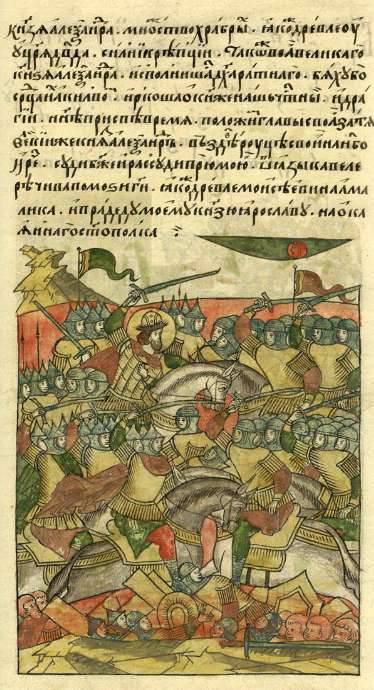
Battle on the Ice. Miniature of the Facial Chronicle, mid-XVI century
In the Russian Federation, the date of victory in the Ice massacre is immortalized as the Day of Military Glory of Russia - the Day of Victory of Russian soldiers of Prince Alexander Nevsky over the German knights on Lake Peipsi. In the Federal Law of March 13 1995-FZ “On the days of military glory (victory days) of Russia”, 32 days are added to the real day of the April 5 battle, 13 is April 18, which is 1242 April, old style, is celebrated on April 5, corresponding to it in a new style at the present time (XX-XXI centuries). Although the difference between the old (Julian) and the new (Gregorian) style in the XIII century would be 18 days.
In 1992, on the territory of the village of Kobylya Gorodishche, Gdovskiy district, in a place as close as possible to the intended site of the Battle on the Ice, a bronze monument to Alexander Nevsky was erected near the church of the Archangel Michael. The monument to the Alexander Nevsky brigade was installed in 1993 on Mount Sokolikh in Pskov.
Picture V.A. Serov "Alexander Nevsky's Entry to Pskov"
Alexander defeats Lithuania
In subsequent years, peace and calm reigned in the Swedish-Novgorod and Novgorod-Order relations. The Swedish and German knights licked their wounds. But the Lithuanian tribes, still scattered, but realizing their strength after 1236, when 22 in September at the battle of Saul (Šiauliai) the swordtails were defeated by the Lithuanians (in this battle Magister Volguin von Namburg (Volkvin von Wintertstatten) and most of the knights brothers fell) , they increased the raids on all the lands adjacent to them, including the Novgorod limits. These raids pursued purely predatory goals and caused legitimate hatred. Russian princes responded retaliatory punitive campaigns.
Soon after the Battle of the Ice, the winner of Western knighthood again had to go on a campaign. Lithuanian cavalry units began to "fight" the Novgorod parish, ruining the border rural areas. Prince Alexander Yaroslavich immediately assembled a army and smashed seven Lithuanian troops into the border area with swift strikes. The fight against the raiders was carried out with great skill - “a lot of Lithuanian princes were beaten up or taken prisoner”.
At the end of 1245, the army, which was headed by eight Lithuanian princes, passed to Bezhetsk and Torzhok. The inhabitants of Torzhok, headed by Prince Yaroslav Vladimirovich, came out against Lithuania, but were defeated. The Lithuanians, capturing a large full and other booty, turned home. However, the militia of the north-western regions of the Vladimir-Suzdal principality - Tverichi and Dmitrovtsy defeated the Lithuanians near Toropets. Lithuanians shut up in the city. Prince Alexander Nevsky came here with the people of Novgorod. Toropets was taken by storm, and all Lithuanians, including princes, were exterminated. All Russian captives were released.
Under the walls of Toropets, Alexander again broke up with the Novgorodians in assessing further actions. He proposed to continue the campaign and punish the discoveries. Novgorod militia with posadnik and tysyatskimi, vladychin regiment led by the archbishop went home. Alexander with his retinue at the beginning of 1246 went through the Smolensk land to the Lithuanian borders, attacked the Lithuanian troops near Zizic and defeated them.
As a result, the Lithuanian princes calmed down for a while. For the next several years, the Lithuanians did not dare to attack Alexander’s possessions. Thus, Alexander Yaroslavich triumphantly won the “small defensive war” with neighboring Lithuania, while not waging aggressive wars. On the borders of the Novgorod and Pskov lands there was a lull.
To be continued ...
1 application. Novgorod first chronicle of the senior and junior izvodov. M.-L., 1950.
In addition, 6750 [1242]. According to Prince Oleksandr from Novgorod and his brother Andre'em and from lower land to Chudsky land on Nyomtsi and Zaya, and to Plskov; and drive out Prince Plskov, seize N´mtsi and Chud, and shack off the flood in Novgorod, and go on Chud himself. And as if on earth, put half into it in prosperity; and Domash Tverdislavich and Kerbet, by way of rozgon, and the middle of Nautsi and Chud by the bridge, and that; and ubisha that Domash, the brother of the land, my husband is honest, and i'm beating him, and iznim with my hands izimash, and bringing a prince to the prince in the polk, the prince will sleep at the lake, n'amtsi and Chüd go on them. Prince Uzleksandr and Novgorod, put a regiment on Chudsky Lakes, on Uzmen, at Voron'ya Kameni; and na hasha for half a year and chyud and run through the pig through half a polkah, and bye svocha that great ntsmtsem and chyudi. God and saint Sophia and the holy martyr Boris and Gleb, for the sake of Novgorod, shed their blood, for the saints with the help of great prayers to the help of prince Alexander; and NЂmtsi tu padosha, and Chüd dasha splashing; and, gonyache, bisha ih on 7-mi across the ice to Subolichskogo shore; and pada Chyudi besshisla, and Nomets 400, and 50 with the hands of Yash and brought to Novgorod. And Bishassya april in 5, in memory of the holy martyr Claudius, to the praise of the holy Mother of God, on Saturday. I send the same letter with a nod: “Bez, the prince of Eesma, came down to Vod, Luga, Pskov, Lotygolu kachem, of all retreat; and that the ezma have withdrawn your husbands, but let us rose: we will let yours go, and you will let ours go ”; and tal Plskovskaya empty and die. The same prince Yaroslav Vsevolodich called the Tsar Tatarsk Batu, the ideal for him in the Horde.
2 application. Konstantin Simonov. Battle on the Ice (excerpt from the poem)
On blue and wet
Cracked ice
At six thousand seven hundred and fifty
From the creation of the year,
Saturday, April 5th
Raw dawn at times
Advanced reviewed
The Germans are a dark build.
On the caps there are feathers of funny birds,
On helmets - horse tails.
Above them on heavy shafts
Black crosses swung.
Squires behind proudly
They brought family shields,
On them coat of arms bear muzzle,
Weapons, towers and flowers ...
... Prince before the Russian regiments
The horse turned from the spread,
Hands bound in steel
Under the clouds angrily poked.
"May God judge us with the Germans
Without delay here on the ice
With us swords, and come what may,
Let's help God's judgment! ”
The prince rode to the coastal cliffs.
Scrambled on them with difficulty,
He found a tall ledge
Where you can see everything around.
And looked around. Somewhere in the back,
Among the trees and stones
His shelves stand in wait,
Keeping horses on a leash.
And ahead, on ringing ice floes
Thundering heavy scales,
Livonians go a formidable wedge -
Pig iron head.
It was the first onslaught of the Germans terrible.
In the infantry Russian angle,
Two rows of equestrian towers
They got their way through.
As in a storm angry lambs,
Among the German shishakov
White shirts flashed,
Mutton hats for men.
In shirts washable body,
Tulups on the ground throwing,
They rushed into a deadly battle,
Wide open the gate.
It's easier to beat the enemy with a flourish,
And if you have to die,
So better clean shirt
His blood to mess.
They are with open eyes
On the Germans were bare breasts,
To the bone fingers slitting,
Bent spears to the ground.
And where the spears crouched,
They desperately slaughter
Through the system of German hacked
Shoulder to shoulder, back to back ...
... people, horses, have already mixed
Swords, axes, axes,
And the prince is still calm
I watched the battle from the mountain ...
... And just waiting for the Livonians,
Having mixed up the ranks, they were drawn into battle,
He, flashing his sword in the sun,
He led the squad for a.
Raising swords of Russian steel,
Bending the spear shaft,
From the forest with a cry flew
Novogorodskie shelves.
On the ice flew with a clank, with thunder,
By shaggy manes leaning;
And the first on a huge horse
The prince entered the German formation.
And, retreating before the prince,
Throwing spears and shields
The Germans fell down from their horses to the ground
Having lifted the iron fingers.
The bay horses were hot,
From under the hooves heaved dust
Bodies over the snow dragged
Stuck in narrow stirrups.
It was a mess
Iron, blood and water.
In place of knight squads
There were blood marks.
Some were lying drowning
In icy bloody water,
Others rushed away, crouching,
Cowardly spur horses.
Under them the horses were drowning
Behind them, the ice rose,
Their stirrups to the bottom pulled
They did not give the shell to swim.
Brelo under glances oblique
A lot of caught gentlemen
First time bare heels
Diligently slapping on the ice.
And the prince, barely cooling off from the landfill,
From under the arm already watched
Like the rest of the fugitives pathetic
To the Livonian lands left.
- Alexander Samsonov
- Great Russian Prince Alexander Yaroslavich
“Whoever comes to us with a sword, will die by the sword.” That was where the Russian land stood and stands! ”
How Alexander Yaroslavich defeated the Swedish knights
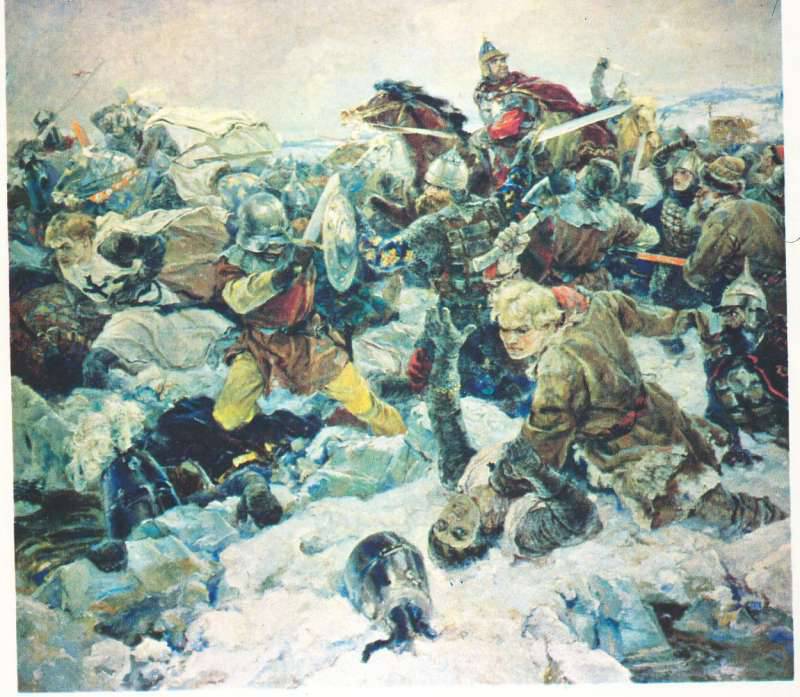
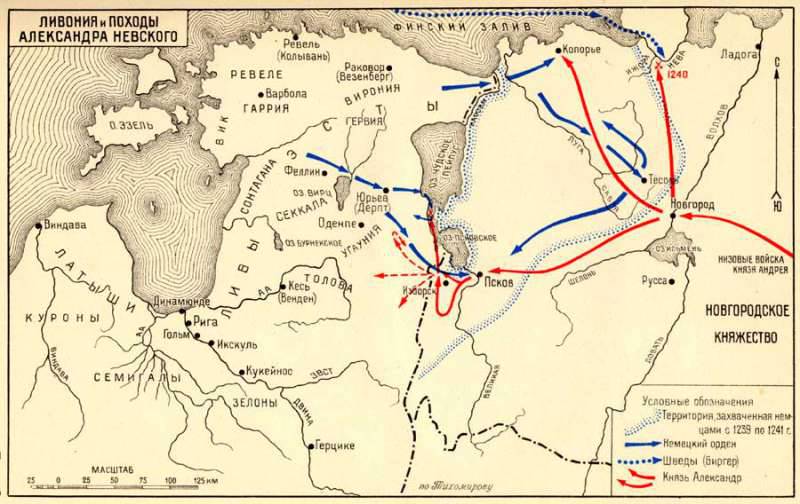
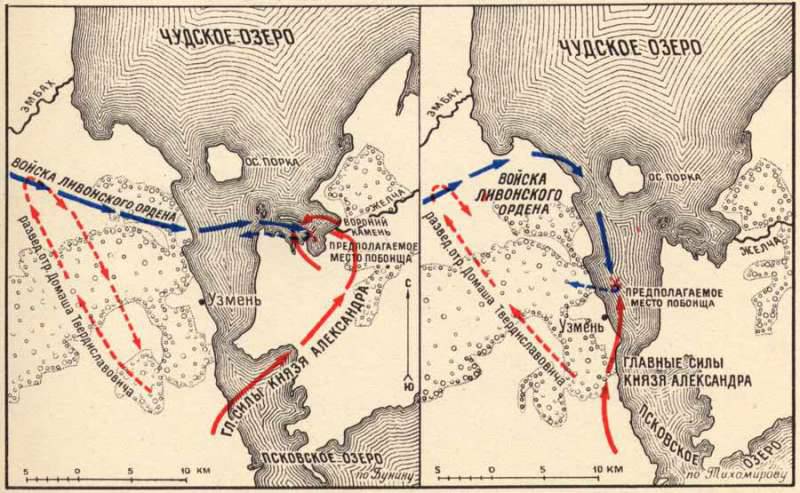
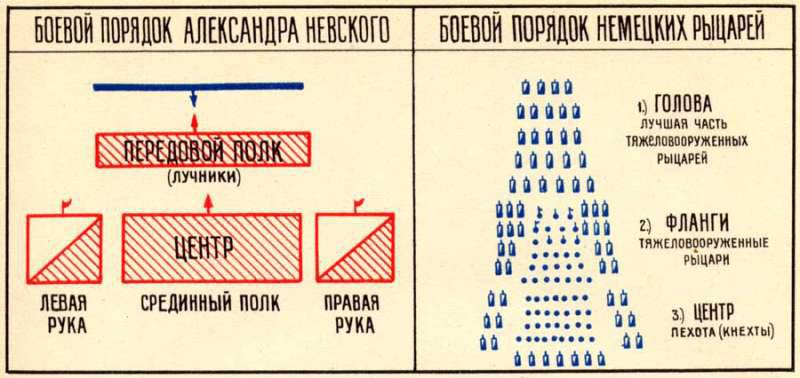
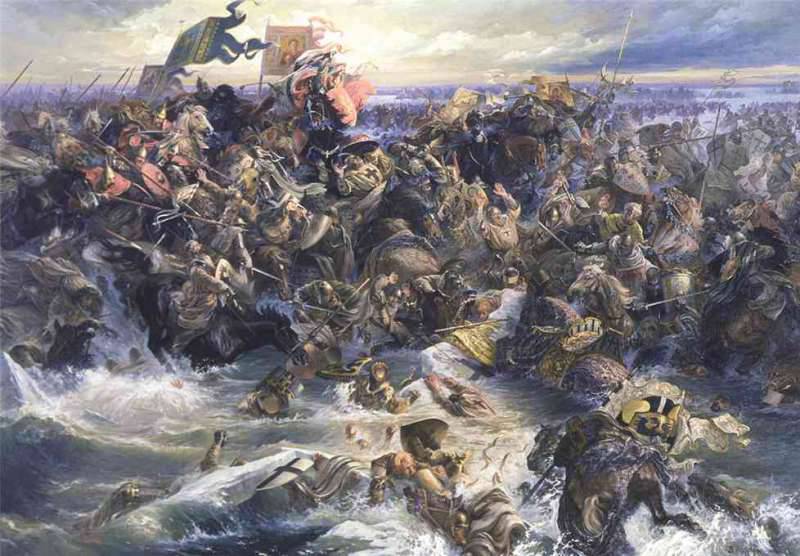
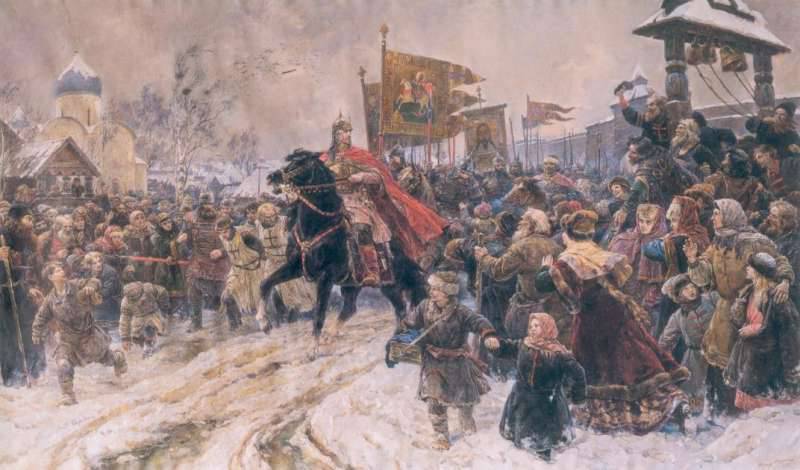
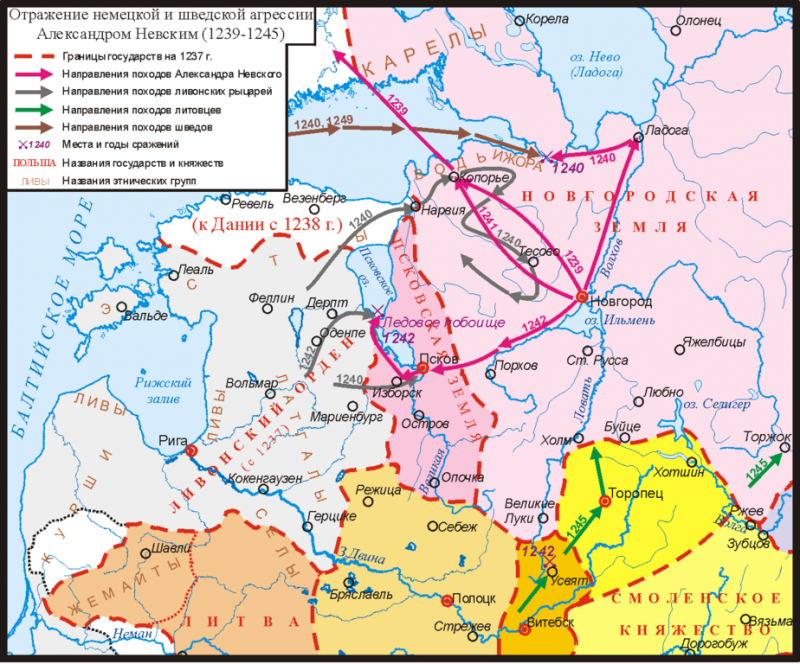
Information